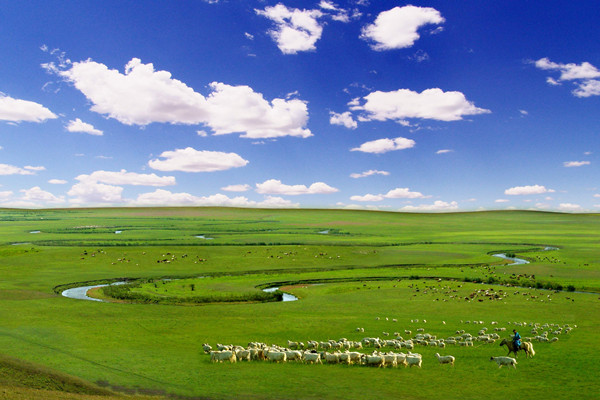Animal husbandry
 |
The grasslands cover about 86.67 million hectares - including 68 million hectares of agricultural grasslands - accounting for one quarter of the country's total. |
Inner Mongolia, with its vast grasslands, is one of China's major bases for husbandry products.
The grasslands cover about 86.67 million hectares - including 68 million hectares of agricultural grasslands - accounting for one quarter of the country's total.
More than 1,000 kinds of forage plants - including about 100 kinds with high feeding value and palatability, such as leymus chinensis, fescue wheatgrass and wild oat - grow in the prairie of the autonomous region, including in Hulunbuir, Xilin Gol, Horqin, Ulanqab, Ordos and Wulate.
The meadow grasslands in northeast Inner Mongolia boast fertile soil, abundant rainfall, and a variety of forage, which provide an ideal environment for livestock breeding, especially cattle. The high nutrition forage on the arid grassland of central and southern Inner Mongolia is good for horses, cattle and sheep, though the species, density and output of forage there are not more than the meadow grassland in northeast..
The desert steppe in the north of Yinshan Mountains and west Erdos Plateau is suitable for breeding small livestock, due to the fat and protein in its forage, in spite of the dry climate and poor species of forage. The desert grassland in the western part of Inner Mongolia is good for raising camels.
Inner Mongolia is known for various livestock, including the Sanhe Hippos, Sanhe Cattle, Red Bulls, Erdos fine-wool sheep and the Arbas Cashmere Goat.
In recent years, Inner Mongolia has continuously worked in the livestock and poultry breeding industries.
Currently, Inner Mongolia has cultivated 23 beef and mutton varieties, making it the region with the highest number of cultivated varieties in the country.
The number of national-level livestock and poultry conservation farms there has reached 11, ranking fourth in the country.
The region has become a leading hub for core breeding farms, boasting 20 such facilities for both cattle and sheep. In fact, it has even climbed the ranks to become the second-highest contributor to the nation's total number of core breeding farms.
In 2024, high-standard farmland construction in the region covered 9.4 million mu (626,666.67 hectares), increasing grain yield per mu by 12.1 kg. Corn and potato yields hit record highs, while beef, mutton, and milk production remained the highest in China.



 Print
Print Mail
Mail





